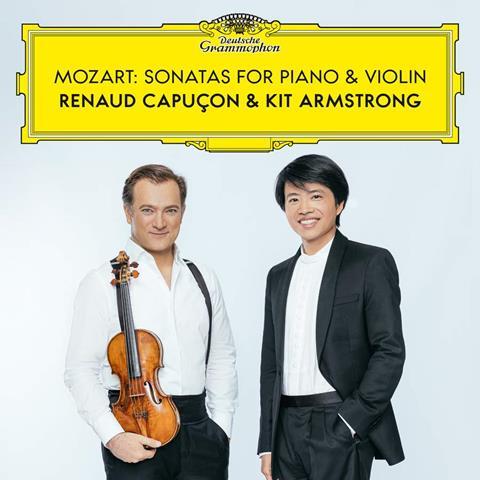A French master finds the perfect partner for compelling Mozart

THE STRAD RECOMMENDS
The Strad Issue: October 2023
Description: A French master finds the perfect partner for compelling Mozart
Musicians: Renaud Capuçon (violin) Kit Armstrong (piano)
Works: Mozart: Violin Sonatas: no.17 K296; nos.18–23 K301–06; nos.24–8 K376–80; no.32 K454; no.33 K481; no.35 K526; no.36, K547; Variations: ‘La bergère Célimène’ K359; ‘Hélas! j’ai perdu mon amant’ K360
Catalogue number: DG 4864463 (4 CDs)
Fun fact: Renaud Capuçon shares his birthday with Mozart – the French violinist is 220 years to the day younger than the Salzburg wunderkind. While Capuçon has had skirmishes with Mozart’s music on record before, he has recently delved deeply into the violin music, with this four-CD set of the mature sonatas to be followed imminently by the five concertos.
It’s customary at this point to remind readers that these are sonatas for piano and violin, in that order, as was standard in the 18th century (and remained so for Beethoven). Nevertheless, while that distinction may hold true for the earliest works, composed by the infant Mozart and not recorded here, experiencing the sequence starting with the Mannheim/Paris set of 1778 and going through to the Viennese sonatas of the mid- and late-1780s shows this to be a bit of a red herring where Mozart is concerned. Right from the outset of the G major Sonata (no.18), the violin is in full-throated diva mode, unfurling a long-breathed vocal line over the piano’s Alberti accompaniment. By the time of the mature late works, the integration of instruments is complete, with both sharing the spotlight, supporting, competing, sparring and cajoling on equal terms.
Watch: Violinist Renaud Capuçon performs in the Paris Metro
Read: Sentimental Work: Renaud Capuçon
Read: ‘It just feels like home’ – Renaud Capuçon on recording Elgar’s Violin Concerto with the LSO
This is music, then, that requires a meeting of minds, and Capuçon seems to have found the perfect foil in the American pianist Kit Armstrong. The recording, made at the Teldex Studio in Berlin, has the piano miked fairly closely but the violin presented with plenty of air around it, highlighting Capuçon’s focus on beauty of tone. Mozart’s lyric lines come to the fore but the naturalness of the pair’s phrasing is such that accompaniment figures never remain just that, consistently shaped and animated with imagination and finesse.
High spirits are the order of the day in many of the earlier sonatas but when Mozart throws a curveball in the form of a work such as no.21 in E minor, its emotional ambivalence stemming from bereavement and the travails of thwarted love, Capuçon and Armstrong draw the listener in with an exquisite balance between defiance and despair. Needless to say, virtuoso passages are thrown off with nonchalant verve. The music making is unforced and natural, and for a tour through the mature sonatas from start to finish – as opposed, say, to Alina Ibragimova and Cédric Tiberghien’s survey of the complete music curated into five mixed programmes on Hyperion – you could hardly do better.
DAVID THREASHER























































No comments yet